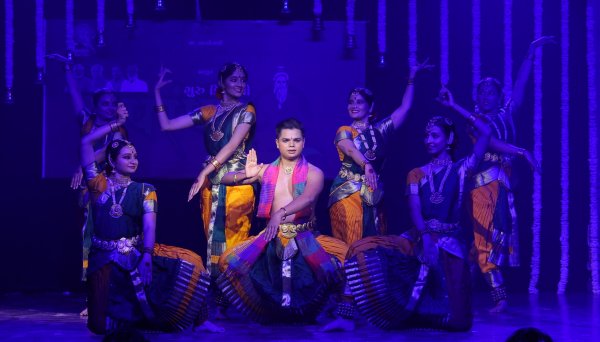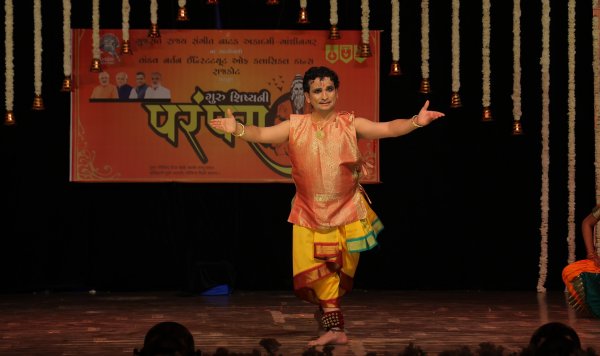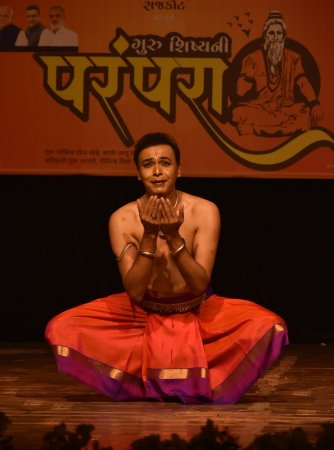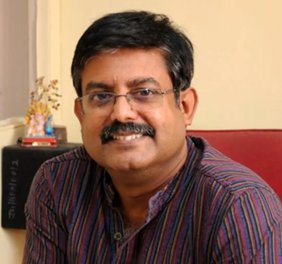
|   |

|   |
The eternal legacy of Guru Shishya Parampara - Bijoy Shivram e-mail: bijoyshivram@gmail.com Photos: Mohit Makvana February 26, 2025 The Guru Shishya Parampara Festival, organized by Tandav Nartan in Rajkot, was a mesmerizing confluence of devotion and dance, paying homage to the sacred lineage of Bharatanatyam. The evening unfolded with the rhythmic precision of Mallari, followed by Satasrushti Tandav and a bhajan by Gujarati saint-poet Narsinh Mehta - Hundi - gracefully presented by Jignesh Surani and his disciples. A poignant Guru Ashtakam by Adi Shankaracharya paid tribute to the boundless grace of the teacher, while a vibrant fusion of devotional Garba, choreographed by Avni Shah, added a celebratory flourish.  Tandav Nartan  Jignesh Surani However, the pinnacle of the night was Vaibhav Arekar's exquisite interpretation of Dashavatar - a performance that transcended storytelling to become a spiritual odyssey, leaving the audience spellbound. Vaibhav Arekar's Dashavatar: A Divine Odyssey Like a lotus blooming amidst a thousand leaves, like a lone star piercing the vast night sky, Vaibhav Arekar's artistry stands apart - a beacon of brilliance in the world of Bharatanatyam. Having witnessed many interpretations of Jayadeva's Dashavatar, one might assume familiarity with its portrayal. Yet, in Vaibhav's hands, the ten incarnations of Vishnu unfolded with fresh vitality, stripping away excess and breathing new life into an age-old narrative. Jayadeva, the 12th-century poet-saint, immortalized the Dashavatar in his Dasakritikrite, weaving Krishna's divine play into the fabric of incarnation. Notably, Krishna himself does not find separate mention, for he is the source from which all avatars emanate. As the evocative lyrics, proclaim: "Keshava dhrta Buddha sharira" - Keshava, another name for Krishna, assumes the form of Buddha. Arekar, a dancer-thinker, embraced this philosophy and distilled it into a performance that embodied the very essence of Vishnu's cosmic dance. From Matsya to Kalki, each avatar sculpted with precision and grace, the transitions seamless, the nritta and abhinaya a confluence of restraint and intensity. Devoid of exaggerated gestural flourishes that often overburden narrative dance, his interpretation was a visual symphony - pure, evocative, and profound.  Vaibhav Arekar Sushant Jadhav's lighting design was nothing short of alchemical, transforming the stage into an ethereal canvas where myth and reality merged seamlessly. His use of luminescence sculpted each moment, amplifying the drama and divinity of the performance. Every frozen frame - whether the formidable stance of Narasimha or the meditative repose of Buddha - bathed in a near-mystical glow, evoking the timelessness of these incarnations. The subtle shifts in hue and intensity not only enhanced the mood but also acted as an unspoken narrator, guiding the audience through the shifting energies of each avatar. His artistry did not merely illuminate; it breathed life into the space, creating a visual poetry that resonated with the grandeur of the performance. The musical landscape, sculpted by Karthik Hebbar's composition and Satish Krishnamurthy's intricate percussion design, elevated Dashavatar into a transcendental experience. Hebbar's melodies did not just accompany the dance; they infused it with soul, weaving an aural tapestry that shifted effortlessly between the meditative and the tempestuous. His compositions carried the weight of mythology, their haunting beauty lingering long after the performance ended. Satish Krishnamurthy's percussive brilliance was the heartbeat of the performance, punctuating movements with precision and poetic cadence. His rhythms, intricate yet fluid, mirrored the shifting energies of each incarnation - from the primordial surge of Matsya to the apocalyptic charge of Kalki. The pulsating beats, delicate silences, and thunderous crescendos all wove together to create an auditory experience that was both visceral and divine. His mastery over rhythm did not just complement the movement; it propelled it, ensuring that every step and gesture resonated with an undeniable force. Together, the triumvirate of Jadhav, Hebbar, and Krishnamurthy did not merely support Dashavatar; they enriched it, elevating the performance to an immersive, almost transcendental experience - where light, sound, and movement converged to create something truly celestial. Vaibhav Arekar is not just a performer; he is a seeker, a contemplative artist who breathes, feels, and inhabits dance in its totality. Each performance is a journey - questioning, refining, and surrendering. Whether an elaborate production or a simple Kirtanam, he approaches every piece with reverence and depth, ensuring that no movement is arbitrary, no expression casual. This commitment to integrity in art makes his performances not just events but experiences - ones that linger long after the final beat fades. His Dashavatar was undoubtedly the jewel of the Guru Shishya Parampara Festival, leaving the audience awestruck, stirred, and transformed. A connoisseur's delight, an aesthete's dream - Vaibhav Arekar continues to redefine the very fabric of Bharatanatyam, reaffirming that true artistry lies not in ornamentation but in the depth of experience it evokes.  Son of journalists K Shivram and Amni Shivram, the first Malayali woman English journalist, Bijoy Shivram is an accomplished Indian classical dancer trained in Bharatanatyam and Kuchipudi. A passionate promoter of the arts and a skilled graphic designer, he currently serves as the Vice Principal of JG College of Performing Arts and the Assistant Director (Operations) overseeing 17 JG colleges. He is also the founder of Preksha, an organization dedicated to the promotion of art and culture in Ahmedabad. Since 2020, Bijoy has curated the YouTube series 'Gurudakshina - An Ode to our Gurus,' celebrating the legacy of mentorship and tradition. |